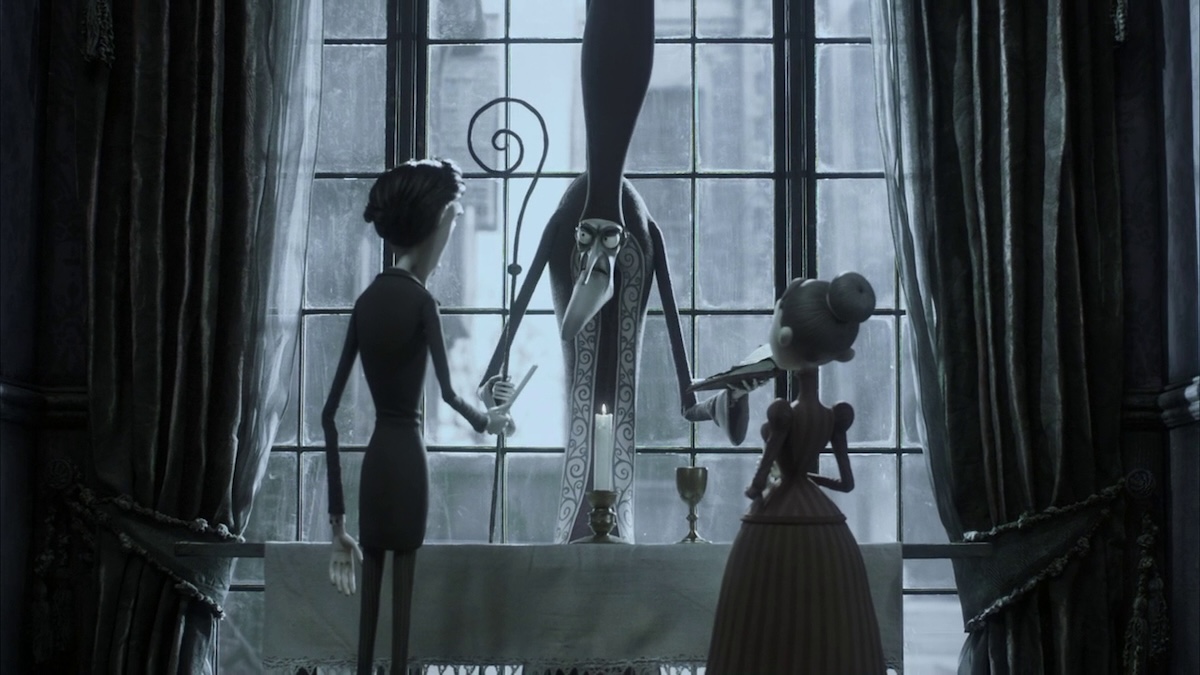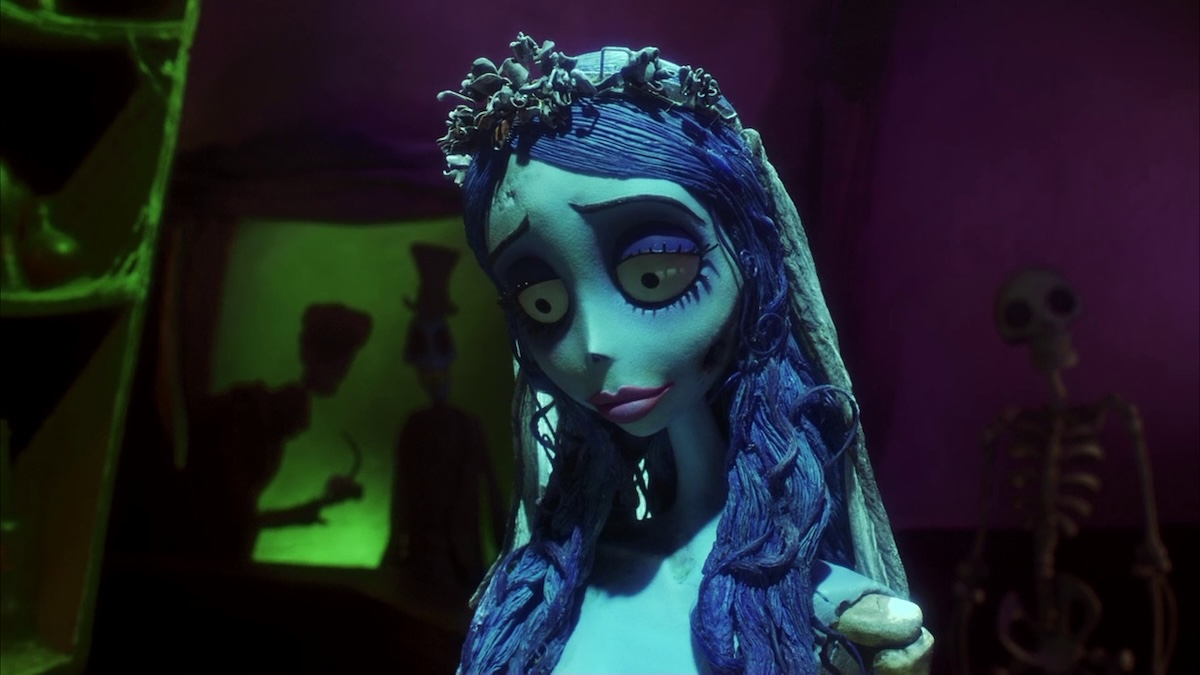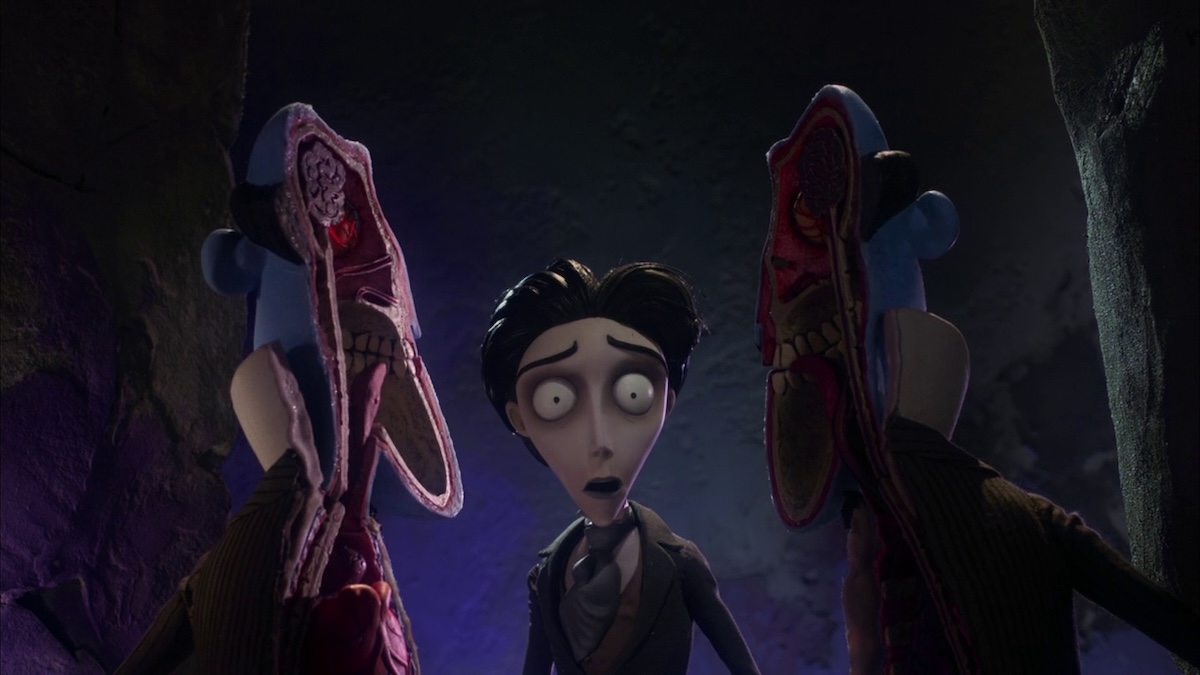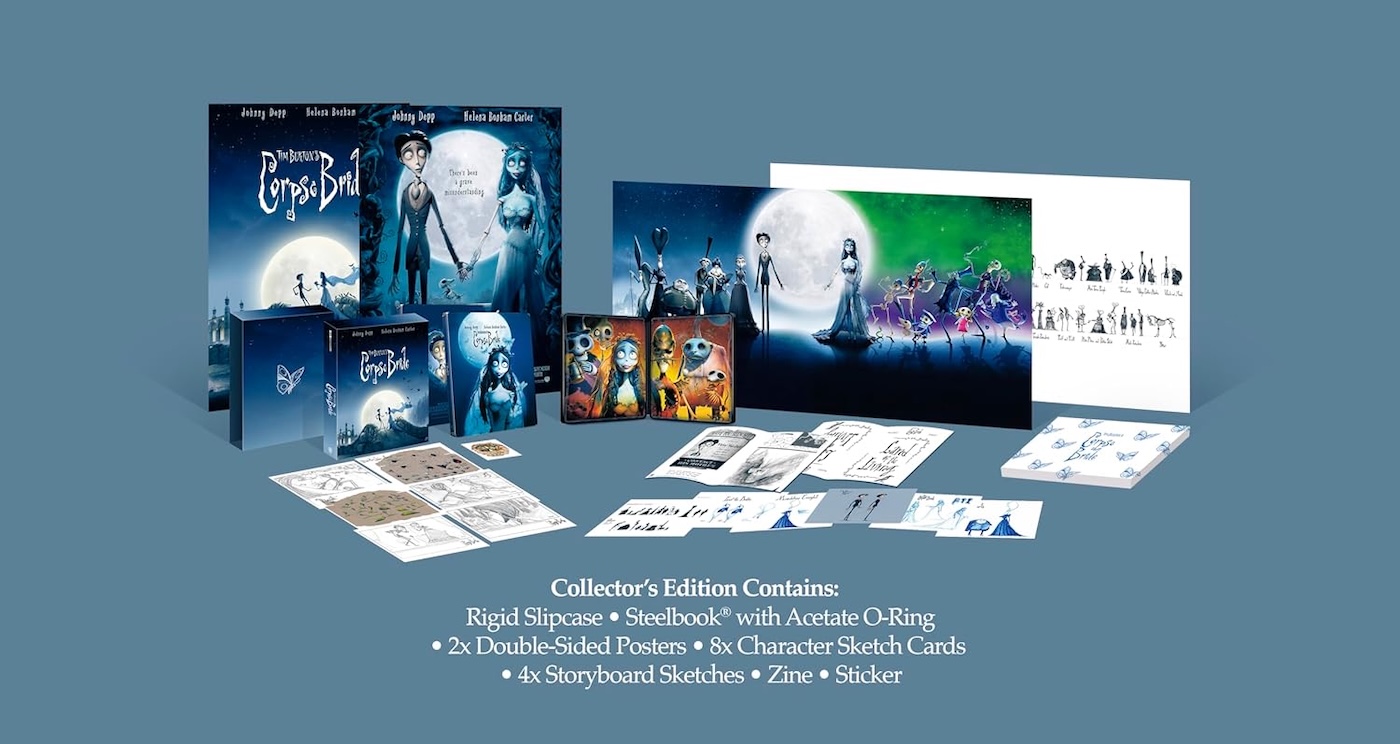CORPSE BRIDE (2005)
When a shy groom practices his wedding vows in the inadvertent presence of a deceased young woman, she rises from the grave assuming he has married her.

When a shy groom practices his wedding vows in the inadvertent presence of a deceased young woman, she rises from the grave assuming he has married her.

Tim Burton’s reputation as an auteur often rests upon his uncanny ability to intertwine the macabre with a peculiar strain of whimsy. While much of his mainstream recognition lingers on Beetlejuice (1988) and Edward Scissorhands (1990),it’s within the realm of stop-motion animation that he has articulated some of his most personal and idiosyncratic visions.Drawing inspiration from pioneers such as Ray Harryhausen (Jason and the Argonauts), Burton first embraced the medium with Vincent (1982). This short simultaneously announced the filmmaker’s aesthetic predilections while establishing the thematic DNA that would inform the misunderstood triumph, The Nightmare Before Christmas (1993).Though nominally directed by Henry Selick, every crooked lamppost and sinisterly grinning pumpkin was lifted straight from Burton’s sketchbook.
Burton was always intent on returning to stop-motion but remained consumed by his Hollywood commitments, including Ed Wood (1994), Sleepy Hollow (1999), and Planet of the Apes (2001). Yet, while he spent over a decade focusing on live-action, the scribblings of a 19th-century Jewish folktale languished in the margins of his aforementioned sketchbook. It was a macabre parable on marriage and fidelity that centred around a cadaverous bride and a callow groom. The auteur admired how the fable functioned as a spectral extension of the mournful romance between Jack Skellington (Chris Sarandon) and Sally (Catherine O’Hara) in The Nightmare Before Christmas.
Initially, Warner Bros. were sceptical about realising the project, since Mars Attacks! (1996) overindulged in CGI spectacle to realise its aliens. However, the studio finally gave the green light once Burton agreed to embrace stop-motion rather than digital trickery. Although directing this tale simultaneously alongside Charlie and the Chocolate Factory (2005) demanded the support of co-director Mike Johnson (James and the Giant Peach), Burton’ very much at the helm. Infused with his particular Gothic whimsy and romantic morbidity, Corpse Bride functions as a continuation of Burton’s preoccupations and a technical evolution of his stop-motion aesthetic.

Set in an unnamed English town where matrimony functions less as a union of hearts and more as a transaction for social climbing, the awkward but tender Victor Van Dort (Johnny Depp) and the equally hesitant Victoria Everglot (Emily Watson) prepare for their marriage. The pair have never met, and this union has been pre-arranged by the struggling aristocrats, the Everglots, seeking salvation through the Van Dorts’ burgeoning wealth. Despite their initial trepidation and uncertainty, Victor and Victoria discover an unexpected spark and quickly become enamoured with one another before instantly falling in love. However, their delicate connection is abruptly fractured when Victor accidentally destroys the rehearsal dinner after his nerves overwhelm him. The nervous groom ruins the ceremony by forgetting his vows, dropping the ring, and accidentally setting Lady Everglot (Joanna Lumley) ablaze.
When a mortified and desperate Victor retreats into a nearby forest, he privately rehearses his vows to the trees. In a moment of tragicomic irony, he slides his wedding ring onto what he believes is a branch. Unbeknownst to the groom, the branch is actually the skeletal finger of a tragically murdered bride, Emily (Helena Bonham Carter). After rising from her grave dressed in a spectral wedding gown and with a ring on her finger, she proclaims herself Victor’s lawful wife. Meanwhile, Lord Everglot (Albert Finney) and Lady Everglot hastily promise the opportunistic Barkis Bittern (Richard E. Grant) their daughter’s hand. His extreme wealth proves a more enticing prospect to the Everglots than Victoria’s own fragile happiness. Once Victor discovers this information, he must choose between fighting for Victoria or remaining with Emily, where the vows he utters might bind them beyond the grave.
Penned by John August (Big Fish), Caroline Thompson (Edward Scissorhands), and Pamela Pettler (Monster House), the screenplay resurrects a rather traditional Victorian Gothic melodrama of mismatched lovers and mistaken identities. Yet, Burton reanimates the skeletal narrative with his unmistakable creative idiosyncrasies, shaping it into a meditation on the duality of life and death that frequently haunts his oeuvre. The oppressed atmosphere of The Land of the Livingdrains the world of its vitality, appearing almost monochrome with a muted palette of grey undertones and the occasional hint of crimson and blue. The gaunt personalities have the pallor of death in their cheeks, like citizens of a repressed Dickensian municipality starved of joy. Whereas the claustrophobic streets and skewed geometries gesture unmistakably toward Robert Wiene’s The Cabinet of Dr Caligari (1920).

Paradoxically, The Land of the Dead explodes with exuberance and feels more alive than the world it ostensibly succeeds. Once Victor tumbles into this underworld alongside Emily, the visual palette erupts with vibrant lime greens and phosphorescent purples inspired by the iconography of Día de los Muertos celebrations. Skeletal bartenders dance around joyously, and half-decomposed aristocrats theatrically express themselves through visual exaggeration. Even the architecture undergoes a metamorphosis with elongated staircases spiralling into infinity and distorted walls arching with whimsical elasticity. In Burton’s meticulously crafted world, the dead are emancipated from earthly societal constructs. Death isn’t annihilation, but a technicolour carnival of liberation inside a rambunctious jazz tavern.
While the narrative carries its own spectral charm, the enduring resonance of this dark and phantasmagorical tale lies in the magnificent craftsmanship with which it’s realised. Released during a time when Pixar dominated the animation landscape, Corpse Bride stands as a tactile reminder that animation is best when imbued with the human touch. The painstaking level of detail and characterisation of each puppet’s movement is truly astonishing. Each frame showcases an astonishing sense of artistry that continues to cast a long shadow over most contemporary digital animations two decades since its release. The process required adjusting the puppets over 28 times per second to create the illusion of continuous motion, which translates to approximately 110,000 movements for the fleeting 77-minute runtime. The result is not only one of Burton’s most visually stunning ventures into stop-motion but also underscores the enduring magic of handcrafted animation.
In contrast to The Nightmare Before Christmas, which relied on a vast library of replacement heads to conjure a wide range of expressions, Burton’s dedicated team of animators manipulated an ingenious system of internal gears and minuscule keys embedded within the armatures with the precision of Swiss watchmakers. These innovative mechanisms allow an unprecedented range of subtle movements to create a variety of expressive performances. If Jack Skellington was broad and theatrical, Victor and Emily are more nuanced and almost human in their fragility. Victor’s nervousness emerges in the anxious twitch of his fingers, while Emily’s sorrow registers in the faintest quiver of her lips. Burton never wastes the creative potential of the medium, demonstrating that stop-motion animation can achieve a level of emotional precision that rivals live performances.

The highly electric and diverse cast also breathe a wonderful amount of spirit into Burton’s skeletal creations. With no preparation and barely any time to remove his Willy Wonka wig, Johnny Depp (Sweeney Todd: The Demon Barber of Fleet Street) provides a surprisingly restrained turn as Victor Van Dort. As the bumbling and deeply insecure son of a fishmonger, his tentative and quivering voice captures the character’s fragility with uncanny precision. It’s a surprisingly elegant performance, considering his career was plagued with overwrought eccentrics during the early 2000s. Counterbalancing his trembling energy, Helena Bonham Carter (Fight Club) imbues the eponymous bride with an astonishing warmth. As Emily, the actress balances the character’s unfulfilled longing with a delicate hint of the whimsical innocence of a dreamer yearning for love. There’s a sense of tragic romance in her performance that renders her irresistibly endearing, transforming Emily from a grotesque novelty into the very soul of this grim fairytale.
The supporting players are also remarkably well chosen, with each actor seamlessly slipping into their role. Emily Watson (Punch-Drunk Love) provides an underrated vocal performance, offering a grounded innocence to Victoria. Albert Finney (Erin Brockovich) lends his formidable voice to the role of Victoria’s blustering father, Finnis Everglot. The late actor delivers his dialogue with a theatricality that borders on the Shakespearean. Meanwhile, Joanna Lumley (The Wolf of Wall Street) relishes every line with acerbic bite as Victoria’s insufferably pretentious mother, Maudeline Everglot. Finally, Christopher Lee (Sleepy Hollow) reminds audiences that even in a minor role, his voice carries the gravitas of an entire cathedral as the Pastor.
The only area where Corpse Bride inevitably suffers is during Danny Elfman’s musical contributions. Audiences seeking the iconic memorability of The Nightmare Before Christmas or the frantic circus of Beetlejuice may find themselves rather underwhelmed. Yet, those attuned to Elfman’s darkly romantic sensibilities should find his delicate fairytale harmonies more sophisticated and deeply rewarding. There’s an undercurrent of sadness coursing throughout this chamber operetta that’s hauntingly beautiful. “Victor’s Piano Solo” becomes a melancholic reflection of the protagonist’s awkward feelings for two women distilled into fragile arpeggios. Whereas Emily’s “Tears to Shed” is a plaintive number of surprising tenderness that affords the character a remarkable sensitivity.

There are occasionally moments where Elfman truly distinguishes himself by unleashing a great deal of carnival jazz and blues. “Remains of the Day” wholeheartedly embraces these styles, providing the musician the opportunity to break out the saxophones and perform as the skeletal vaudevillian, Bonejangles. It’s a spirited cabaret that recalls the grotesque theatricality of The Nightmare Before Christmas’s “Oogie Boogie’s Song” with a hallucinogenic twist. It’s unfortunate that Elfman’s score never attained the cultural permanence of his most celebrated collaborations with Burton. Regardless, it’s a wonderful marriage of sound and subject matter that provides some much-needed narrative backbone.
Though Corpse Bride may never eclipse the cultural permanence of The Nightmare Before Christmas nor match the anarchic irreverence of Beetlejuice, it remains an enchanting visual experience two decades since its release. The meticulously crafted stop-motion animation is beautifully realised and reaffirms the vitality of a medium many had once presumed archaic. In doing so, it laid crucial groundwork for the resurgence of the medium, inspiring subsequent works such as Coraline (2009), ParaNorman (2012), and Kubo and the Two Strings (2016). Admittedly, the screenplay is predictable in its structure and conventional in its resolutions, offering very little in the way of narrative surprise. Yet, what it lacks in originality, it compensates through its visual splendour and tonal atmosphere. Tim Burton utilises his signature gothic whimsy, morbid detail, and macabre wit to offer audiences a bittersweet meditation on love, death, and the liminal space that separates the two.
USA • UK | 2005 | 77 MINUTES | 1:85:1 | COLOUR | ENGLISH


Making its debut on 4K Ultra HD Blu-ray, Corpse Bride has been given a wonderful restoration courtesy of Warner Bros. Home Entertainment. Showcasing an immaculate 2160p transfer, the image is presented in its original 1.85:1 aspect ratio.
Despite much of the runtime playing out in near monochromatic tones, it’s surprising how the largely muted palette still delivers a visually compelling experience. The Dolby Vision HDR lends an unexpected richness to the subdued imagery of the Land of the Living. Black levels are consistently inky, and highlights gleam with striking luminosity, whereas various shades of grey and nuances of colour are expertly handled. Yet, it’s when Victor descends into the Land of the Dead that the colour reproduction truly dazzles.
A wide variety of bold primaries and vibrant secondary hues burst across the frame, resulting in a truly eye-popping experience. Colour palette aside, the transfer also boasts a treasure trove of textural excellence. The image is deceptively sharp, and it’s truly amazing just how detailed both the puppets and the production design are. From the fine etchings on picture frames to the intricate stitching of Emily’s dishevelled bridal gown, the transfer maintains a consistent amount of clarity. Overall, this new restoration delivers a cleaner and more stable image when compared to Warner Bros. Home Entertainment’s previous transfer.
The 4K release only features one audio track with optional subtitles in several languages. Unfortunately, Warner Bros. Home Entertainment’s release doesn’t receive a Dolby Atmos upgrade, but it provides an immersive English DTS-HD 5.1 Master Audio that boasts excellent fidelity and dynamism. Danny Elfman’s hauntingly romantic score sounds precise and reverberates across the soundstage throughout the presentation. The orchestral strings are dispersed evenly across the side and rear channels, whereas the strong sounds of blues and jazz remain primarily at the front. A variety of atmospherics directed towards the rears generate a constantly active and highly engaging soundscape, especially when Victor first visits The Land of the Dead. There’s an enveloping presence of subtle effects such as crowd noises, footsteps, and creepy acoustics. The result is a terrific sense of envelopment, with an all-encompassing sound field always alive with sound.

directors: Mike Johnson & Tim Burton.
writers: John August, Caroline Thompson & Pamela Pettler (based on characters created by Tim Burton & Carlos Grangel).
voices: Johnny Depp, Helena Bonham Carter, Emily Watson, Albert Finney, Joanna Lumley, Tracey Ullman, Paul Whitehouse, Richard E. Grant & Christopher Lee.
